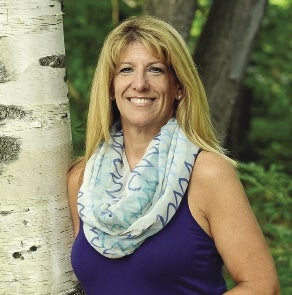Alternative medicine meets the mainstream
When Georgianna Donadio began practicing chiropractic medicine in Massachusetts in 1976, she had her skeptics.
Some members of the mainstream medical community were wary of the discipline, and Donadio said she even was once accused in a print article of “heresy” after delivering a presentation in which she asserted that a person’s outlook and lifestyle had an impact on their physical health.
But those days are gone. Now the program director at the National Institute of Whole Health, based in Wellesley, Donadio holds a doctoral degree and is a professor of health sciences.
Today, her “integrative background” in health care, as she calls it, doesn’t stand out as it once did. Attitudes about alternative medicine, she said, are cyclical; homeopathic medicine was popular among consumers when she first started out, but then it waned for a while before resurging.
“Right now, we are in a cycle of natural health care again,” Donadio said.
Nearly 2 in 5 using it
The numbers appear to back up Donadio’s assertion. Though data collected by the National Institutes for Health (NIH) lags by several years, the most recent report on the use of complementary and alternative medicine published in 2008 showed that about 38 percent of U.S. adults used some form of medical therapy outside the realm of mainstream medicine. The NIH includes several therapies under the umbrella of complementary and alternative medicine, such as acupuncture, massage, hypnosis and mediation.
Clearly, consumer interest is strong, and that means major health care providers want in on alternative medicine, Donadio said, adding that this has been the case for at least a decade in the Greater Boston area, where all major hospitals offer some sort of integrative medicine that merges alternative therapies with mainstream treatments for patients dealing with chronic health issues.
Central Massachusetts providers tend to be a little more parochial in Donadio’s experience, but providers here have also embraced the field in recent years as more people inquire about it.
“If the major medical centers are making money off of it, they’re more than happy to provide it,” Donadio said.
Integrative medicine programs may not always be designed strictly to generate revenue, however.
UMass Memorial's offerings
UMass Memorial Health Care, the region’s largest health care system, offers an integrative medicine initiative for cancer patients, offering weekly complementary care therapies such as yoga, guided imagery and deep-breathing exercises.
Meanwhile, HealthAlliance Hospital, the UMass Memorial affiliate with campuses in Leominster and Fitchburg, offers similar services to cancer patients, but also to the general public at its Simonds-Hurd Complementary Care Center in Fitchburg.
Simonds-Hurd opened in 2010 and grant funding pays for complementary therapies to help ease the side effects of the cancer treatment patients receive on the same campus, according to Lynn Gerrits, a holistic practitioner who manages the center. But the center also operates on a fee-for-service basis, taking patients who have been referred by doctors in the community.
The cancer doctors see how effective the center’s treatments are at reducing side effects, and often encourage their patients when they start their courses of treatment to seek such therapy as acupuncture, hypnosis or Reiki, Gerrits said.
Meanwhile, physicians who specialize in other areas of medicine tend to send patients who suffer from chronic pain and haven’t responded to other treatments.
“We try to work as closely as possible with the physicians … to help them understand how these modalities can work together with the health care they’re providing,” Gerrits said.
Gerrits said she has seen a general softening within the medical community toward alternative therapies as a way to complement other pain treatments, which often include the use of opiates and narcotics. As Gerrits sees it, alternative therapies offer a safe alternative to these drugs, which frequently lead to addiction.
College catches on
But don’t take it strictly from an alternative medicine practitioner. Other recent local developments in alternative medicine provide further evidence that mainstream medical professionals who focus believe in its efficacy.
The announcement earlier this month that MCPHS University (formerly the Massachusetts College of Pharmacy and Health Sciences), which has a Worcester campus, had bought the New England School of Acupuncture (NESA) is a high-profile example. At the time, MCPHS President Charles F. Monahan, Jr. said holistic medicine is a $20 billion industry that’s drawing the interest of many students. Now, MCPHS offers two master’s degree programs in acupuncture through NESA.
Lana Dvorkin Camiel, a professor of pharmacy who works within MCPHS’ Center for Drug Information and Natural Products, which provides information on herbal treatments and dietary supplements, said that since patients are demanding alternative medicine, higher education institutions need to tailor coursework to encompass it.
“We feel we are preparing our students for practice,” Camiel said.
Meanwhile, Dr. Marcus Cooper, a cardiologist at UMass Memorial Medical Center in Worcester, recently launched his first wellness venture: a therapeutic massage studio in Shrewsbury, Massage Ultra.
The deep-tissue massage offered there is designed to promote healing from musculoskeletal injuries and migraine headaches, and help patients tackle behavioral health challenges, such as losing weight and quitting smoking.
With a medical degree from The Johns Hopkins University School of Medicine, Cooper said therapeutic massage can boost dopamine levels while reducing cortisol, a stress hormone, for one to two weeks after treatment. That goes a long way in helping people make behavioral health changes without medication, he said.
While the long-term health benefits are difficult to measure with clinical studies, patients rave about therapeutic massage, according to Cooper.
“And we can’t just dismiss that,” he said.
(Note: This story was updated to include the correct year of the opening of the Simonds-Hurd Complementary Care Center. The story was also updated to clarify that Lynn Gerrits manages the center.)















0 Comments